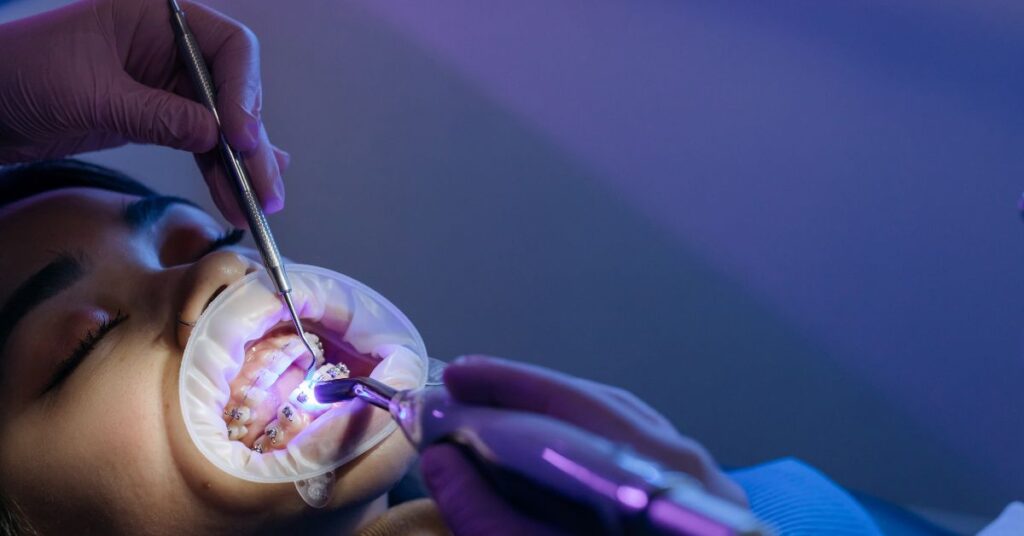A straight smile is something many people dream of, but the idea of wearing braces can feel overwhelming. Metal brackets and wires bring to mind food restrictions, painful adjustments, and a big change in lifestyle.
Thankfully, orthodontic treatment has advanced, and today many patients are turning to Clear Aligners. These modern devices are often chosen for their discreet look and flexibility.
But beyond the cosmetic advantage, people often wonder: how do they affect everyday life? Let’s break it down in simple terms.
Table of Contents
ToggleHow Clear Aligners Fit Into Daily Life
Living with Clear Aligners feels very different compared to traditional braces. Since the trays are removable, most daily activities like eating, drinking, and brushing your teeth stay almost the same. That said, they do require some planning and consistency.
Eating and Drinking with Aligners
One of the biggest perks is the ability to eat what you like. Unlike braces that come with a long list of restrictions,no popcorn, sticky candy, or hard foods,aligners can be taken out before meals.
This makes them especially helpful for people in busy cities like South Delhi, where social dining and street food are part of daily culture.
With Clear teeth straighteners, you don’t have to worry about giving up your favorite foods; the only rule is that aligners should not be worn while eating or drinking anything besides water.
Hot beverages and sugary drinks can damage the trays or trap sugars against your teeth. Patients often learn to carry their aligner case everywhere so they can store them safely during meals.
Brushing and Flossing
Oral hygiene is easier compared to braces. Since aligners are removable, you can brush and floss normally without struggling around wires. The only change is that you may need to clean your teeth more often.
Dentists usually recommend brushing after every meal to prevent food particles from sitting between teeth and trays.This step can take some adjusting at first.
For students or working professionals in south Delhi, it might mean keeping a small dental kit in your bag for quick cleanups between classes or office meetings. Over time, this becomes second nature.
Speech and Comfort
At the beginning of treatment, many people notice a slight lisp when speaking. This happens because the aligners are new and your tongue needs time to adapt. The adjustment period usually lasts only a few days to a week. Reading out loud or practicing conversations can help speed up the process.
Comfort is another area where aligners stand out. While braces can irritate cheeks and lips, aligners are smooth and cause little discomfort. Some pressure is normal whenever you switch to a new set of trays, but this simply means your teeth are moving as planned.
Building Aligners Into Your Routine
A successful treatment depends on consistency. Aligners need to be worn for 20–22 hours a day to work effectively. This means patients should only remove them for meals, drinks, and brushing. Missing hours regularly can slow down progress and extend treatment time.
Daily Reminders and Tracking
In today’s digital age, many aligner providers offer apps that help track wear time. Some apps remind patients when it’s time to switch to the next set of trays. Setting phone alarms or keeping a daily log can also be helpful.
Nighttime Habits
Most people sleep with their aligners in, which makes it easier to reach the required hours. At night, trays should also be rinsed and stored properly if removed. Some patients soak them in a cleaning solution to keep them fresh and clear.

Impact on Social and Work Life
One of the top reasons adults choose aligners is that they fit smoothly into professional and social settings. Since they are nearly invisible, most people won’t even notice you’re wearing them.
Confidence in Public
Whether you’re giving a presentation at work, attending a wedding, or going out with friends, aligners rarely draw attention. This makes them a good option for teenagers who feel self-conscious about their appearance and for adults who don’t want braces to affect their image.
Travel and Busy Schedules
For people who travel often, aligners are easier to manage than braces. There’s no need for emergency visits if a bracket breaks. Instead, patients carry their next set of trays along. For longer trips, dentists sometimes provide extra aligners in advance.
Managing Challenges in Daily Routines
While aligners are convenient, they still come with responsibilities. Here are some common challenges and how people handle them.
Remembering to Put Them Back In
After meals, it’s easy to forget to put the trays back in. To avoid this, patients keep their aligner case visible,on the dining table, in a lunchbox, or in their pocket. Some even set reminders to avoid losing track.
Keeping Aligners Clean
Aligners can stain if not cleaned regularly. Dentists suggest rinsing them under lukewarm water every time they’re removed. Daily brushing with a soft toothbrush helps too. Special cleaning tablets are available but optional.
Dealing with Pressure
Each time you change to a new tray, there may be mild soreness for a day or two. Most patients compare it to the feeling of tight shoes that soon adjust. Over-the-counter pain relievers can help, but many find they don’t need them after the first few days.
How Daily Routines Become Easier Over Time
At first, wearing aligners requires extra thought. But as weeks go by, most people find it becomes second nature. Carrying a case, brushing after meals, and cleaning trays simply blend into the day. Patients often say the effort feels worth it once they see their smile changing in the mirror.
Another benefit is fewer dental visits compared to braces. Most aligner checkups happen every six to eight weeks, saving time for busy students, parents, and professionals.
Supporting Details: Real-Life Experience
Many patients share that the freedom to remove aligners during special moments makes a big difference. For example, a college student in south Delhi mentioned how easy it was to attend a friend’s birthday dinner without worrying about food restrictions. After enjoying the meal, she simply brushed her teeth and popped the aligners back in.
Similarly, working professionals appreciate that they can attend client meetings without worrying about how their smile looks. The near-invisible trays allow them to stay confident while still working on their dental health.
Lifestyle Adjustments That Matter Most
Carrying Essentials
Most aligner users quickly learn to keep a small kit with them. This might include:
- A toothbrush and travel-sized toothpaste.
- A floss pick or small interdental brush.
- The aligner case to store trays safely.
Having these items on hand makes it easy to maintain oral hygiene even when out all day.
Eating Out
When dining with friends or colleagues, aligner wearers usually excuse themselves to the restroom to remove trays. It becomes a normal step, just like washing hands before a meal. After eating, brushing or at least rinsing helps before popping them back in.
Special Occasions
Some people temporarily remove aligners for short events like photo sessions or weddings. As long as this is rare and trays are worn most of the time, it doesn’t affect progress. This flexibility is something patients with braces don’t get to enjoy.
Emotional and Psychological Benefits
Beyond the physical routine, aligners often influence how patients feel about themselves. Many people report a boost in self-esteem during treatment, not just after it ends. Knowing that their teeth are improving,even if results take months,gives them more confidence in daily interactions.
Teenagers often feel more at ease compared to wearing braces, which can make them targets of teasing. Adults, especially those in client-facing jobs, like that they can improve their smile without announcing it to the world.
Aligners and Family Life
Parents whose children wear aligners also notice differences in routine compared to braces. Without emergency visits for broken wires, schedules are easier to manage. Aligners also mean less worry about kids avoiding certain foods.
For adults in family roles, aligners often inspire children to care more about dental hygiene. Parents wearing them set an example for kids about brushing and flossing regularly.
Aligners and Fitness Routines
Some people wonder whether aligners affect sports or workouts. The good news is that they don’t. Aligners fit snugly and rarely interfere with exercise. In fact, they can sometimes provide a bit of protection for teeth during low-contact sports.
For higher-contact sports like football or martial arts, patients may remove them and switch to a protective mouthguard during play. Dentists usually guide patients on how to balance safety with treatment progress.
The Role of Professional Guidance
Dentists play a key role in helping patients adjust. From teaching proper cleaning methods to checking whether trays fit correctly, regular visits keep treatment on track.
Clinics like Teeth Aligners in India often provide starter kits, detailed instructions, and ongoing support to make sure patients adapt smoothly.
Long-Term Outlook After Treatment
Daily routines with aligners last for the duration of treatment, which may range from 6 months to 2 years depending on the case. Once completed, most patients switch to retainers.
Retainers are usually worn at night to keep the new smile in place. This feels much easier since it doesn’t affect meals or daily schedules.
Conclusion
Clear aligners have changed the way people think about orthodontic care. They offer a blend of comfort, flexibility, and convenience that fits well into modern lifestyles.
From easier eating and cleaning to maintaining confidence in social settings, they help people straighten their teeth without feeling like their lives are put on hold.
For anyone considering this treatment, choosing a trusted clinic such as Teeth Aligners in India can make the process smooth and effective.

